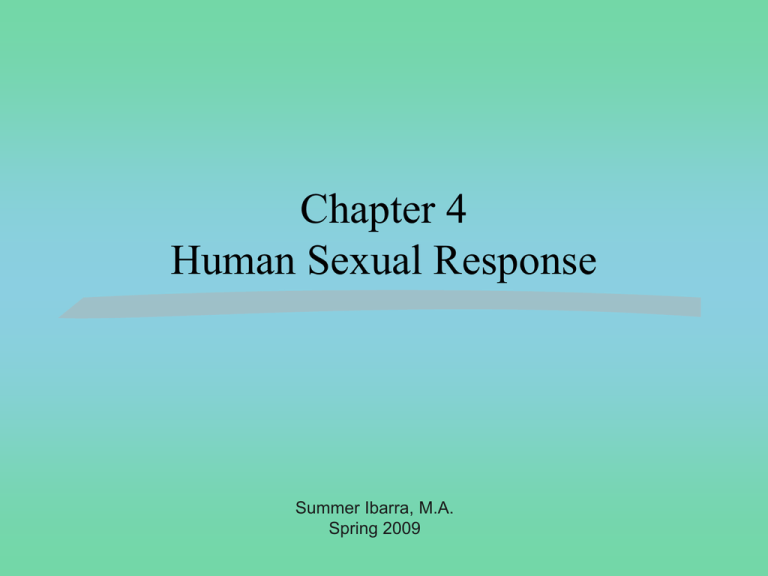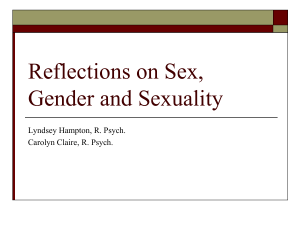
Chapter 4
Human Sexual Response
Summer Ibarra, M.A.
Spring 2009
Models of Human Sexual
Response
Masters & Johnson
Four-Phase Model
Excitement
Plateau
Orgasm or climax
Resolution
Kaplan
Three-Phase Model
Sexual desire –
psychological component
Vasocongestion
Orgasmic release
Sexual Desire
• Women tend to “romanticize” the goals of
sexual desire (love, emotional intimacy,
commitment), while men are more likely to
“sexualize” it (goal is sexual activity).
• No difference in cognitive processing of
sexual info. between men and women, but
there are distinct differences in emotional
processing
Activating the Response:
Components of Sexual Arousal
Internal Stimuli
Central Arousal System
Emotional & pleasure centers
of the brain
When the mind ascribes sexual
meaning, genital physiological
arousal can be automatic
External Stimuli
Peripheral Arousal System
Cues from skin, genitals, nervous
system, and senses
Research suggests women are less likely to pick up on the
physiological cues of their own sexual arousal, though their
genitals tends to show response just as quickly as men’s.
Female Sexual Response
(Masters and Johnson’s Model)
Excitement Phase
Vasocongestion and other changes in the genital region
Vagina becomes lubricated with an alkaline fluid
Plateau Phase
Increased changes in the vagina
“Orgasmic platform” is created
Breasts may become swollen and nipples may become erect
Increase heart rate, respiration, and blood pressure
Orgasm
Heart rate, respiration, and blood pressure reach peak
Several muscle contractions of vagina and anal area
Pleasurable feelings throughout the body
Resolution
Body returns to unexcited state
Drowsiness may occur as muscles relax
Female Sexual Response
Copyright (c) 2006 by The McGraw-Hill Companies, Inc. All rights reserved.
Female Orgasm and G-Spot
Tend to reach orgasm slower than men during intercourse
Reach orgasm more quickly through masturbation
Two types of orgasm:
clitoral
Vaginal – “uterine orgasm”
Some have a “blended orgasm”
G-spot – area on the inner front wall of the vagina that is
very sexually sensitive (though not found in all women)
http://www.youtube.com/watch?v=sKupxneQDB8&featur
e=related
Start video at 3:30 in
Male Sexual Response
Excitement Phase
Vasocongestion leads to erection of the penis
Muscular tension increases throughout the body
Plateau Phase
Testes may increase in size by 50 percent
Cowper’s glands often secrete fluid
Glans of the penis becomes swollen
Increased heart rate, respiration, and blood pressure
Orgasm
“Ejaculatory inevitability” – distinct inner sensation that orgasm is
imminent and sense that ejaculation cannot be stopped
Strong muscle contractions at base of penis and anal area
Semen is expelled
Pleasurable feelings throughout the body
Resolution
Body returns to unexcited state, process may take two hours
Drowsiness and relaxation (Refractory period begins)
Male Sexual Response
Copyright (c) 2006 by The McGraw-Hill Companies, Inc. All rights reserved.
Male Sexual Response
“Male orgasm and ejaculation should be viewed as
two essentially separate sexual responses that most
often happen at the same time.”
Some research suggest a small number of men
(about 5%) experience multiple orgasms, but this
is not typical due to the refractory period
During the refractory period, men often cannot be
restimulated to orgasm for some time (about 30
minutes for men in their late thirties)
Organizing & Activating Effects
of Hormones
Organizing Effects – ways in which hormones control
patterns of early development in the body
Control development of sex glands, external genitals, and nervous
system in the fetus
Activating Effects – the direct influence some hormones
can have on activating or deactivating sexual behavior
May activate or deactivate sexual behavior
Central arousal system is more influenced by hormones than the
peripheral arousal system
Testosterone acts as an activator for sexual desire in both
men and women
Male hormone (androgen) produced by the ovaries in females and
by the testes in males
Males have higher levels of testosterone than females, but females
are more sensitive to testosterone
Effects of Aging on Sexual
Response
Females
Thinning of vaginal lining
Reduced lubrication
Cramping with orgasm
Longer time for arousal to
occur
Longer time to reach orgasm
Fewer muscular contractions
with orgasm
While the frequency of sexual
activity decreases, men and
women remain sexually responsive
and continue to experience sexual
pleasure as they age.
Males
Takes longer to achieve a full
erection
Reduction in amount of semen
Longer time to reach orgasm
Reduced strength of orgasmic
contractions
Lengthening of refractory
period
Sexual Response Quiz Game
Objective: To test students’ knowledge on female and male sexual response as per Table 4-1
(Female and Male Sexual Response) in the main text
Method:
Divide students into groups of four to five per group.
Instructor establishes an order of which group answers first to last.
Instructor reads a sexual response from Table 4.1.
The first group tries to answer which phase the statement comes from; if they answer
incorrectly, the instructor may choose to read the same statement to the next group or
read a new statement.
For each correct answer, the group will receive 1 point.
The group with the most points wins.
This activity might be best served as a review for the test.
Upon completion: Students will have a gauge of their knowledge on the sexual
response cycle
Orgasm Description Activity
Objective: Students will gain a better understanding of the descriptive similarities of male
and female orgasms.
Method:
Have students write an anonymous, gender-free description of their orgasmic
experiences.
Besides describing the physical sensations, encourage students to include the
psychological and emotional aspects.
Be aware that some students may not have had an orgasm. They would write on their
anonymous paper “Do not know yet.” State that this paper is not for a grade.
Have students write an M or F at the top of the paper so that you, the instructor, will
know if a male or female wrote the paper.
Collect the papers, then read several out loud and let the students vote as to whether
they think a male or female wrote it.
What usually occurs is that most students pick a paper that they think is written by a
male; however, it turns out that it was written by a female and vice versa.
Upon completion: Students will become aware that how they describe orgasm is
quite similar compared to the stereotypical view.








